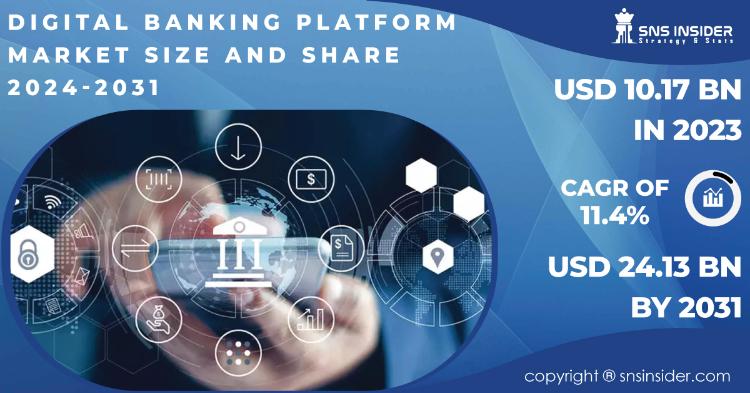Digital Banking Platform Market Insights | Understanding Industry Dynamics
Digital Banking Platform Market Insights | Understanding Industry Dynamics
|
Digital Banking Platform Market Scope and Overview The banking industry is undergoing a profound transformation driven by digital innovation, changing consumer expectations, and evolving regulatory requirements. Digital banking platforms have emerged as key enablers of this transformation, empowering banks and financial institutions to deliver seamless, personalized, and omnichannel banking experiences to their customers. The Digital Banking Platform Market Report offers an in-depth analysis of the global digital banking landscape, highlighting key trends, opportunities, challenges, and emerging technologies shaping the future of banking. Market Analysis The Digital Banking Platform Market is experiencing rapid growth fueled by the increasing adoption of digital technologies, shifting consumer preferences, and competitive pressures within the banking industry. Digital banking platforms encompass a wide range of solutions and services, including online banking, mobile banking, digital payments, open banking, and digital lending, aimed at enhancing customer engagement, driving operational efficiency, and enabling innovation in banking services. Get a Sample Report of Digital Banking Platform Market @ https://www.snsinsider.com/sample-request/1228 
Key drivers of growth in the Digital Banking Platform Market include:
The Digital Banking Platform Market is characterized by a diverse ecosystem of vendors, including traditional core banking providers, fintech startups, software vendors, and IT service providers. Leading digital banking platform vendors such as Temenos and Oracle Financial Services dominate the market, offering comprehensive platforms and solutions tailored to the needs of banks and financial institutions worldwide. Market Segmentation and Sub-Segmentation Included Are: By Component:
By Deployment type:
By Banking type:
Competitive Landscape The competitive landscape of the Digital Banking Platform Market is characterized by intense competition and innovation as vendors vie for market share and differentiation. Traditional core banking providers such as Fiserv and FIS are expanding their digital banking offerings through organic growth, acquisitions, and partnerships to meet the evolving needs of their customers. Fintech startups and challenger banks are disrupting the traditional banking industry by offering innovative digital banking solutions that prioritize user experience, agility, and customization. These agile and customer-centric players are leveraging cloud-native architectures, APIs (Application Programming Interfaces), and microservices to deliver modern, frictionless banking experiences that resonate with digital-savvy consumers. Some of the Major Key Players Studied in this Report are:
Software vendors and IT service providers are also playing a key role in the digital banking ecosystem by offering a wide range of solutions and services, including digital banking platforms, cybersecurity, cloud migration, and digital transformation consulting. Strategic partnerships, acquisitions, and investments in research and development are driving innovation and collaboration in the digital banking market as vendors seek to address evolving customer needs and market demands. Regional Outlook The Digital Banking Platform Market exhibits a global presence, with significant growth opportunities in key regions such as North America, Europe, Asia-Pacific, Latin America, and the Middle East and Africa. North America remains the largest market for digital banking platforms, driven by the presence of leading technology companies, high levels of digital adoption, and robust regulatory frameworks. Europe is also a major market for digital banking platforms, with strong demand from banks and financial institutions seeking to comply with open banking regulations, improve customer engagement, and drive innovation in financial services. Asia-Pacific is witnessing rapid growth in digital banking, fueled by factors such as the proliferation of mobile devices, rising internet penetration, and government initiatives to promote digital financial inclusion. Latin America and the Middle East and Africa are emerging markets with significant potential for digital banking platform adoption, driven by factors such as urbanization, expanding middle class, and increasing demand for digital financial services. Each region presents unique opportunities and challenges for digital banking platform vendors and organizations, influenced by factors such as regulatory environment, technological infrastructure, market maturity, and consumer behavior. Opportunities for Market Growth The Digital Banking Platform Market presents several opportunities for growth and expansion:
By capitalizing on these opportunities, digital banking platform vendors and financial institutions can enhance customer engagement, drive operational efficiency, and unlock new revenue opportunities in the evolving digital banking landscape. Conclusion In conclusion, the Digital Banking Platform Market represents a dynamic and transformative force that is reshaping the future of banking and financial services. With its potential to improve customer engagement, drive operational efficiency, and foster innovation, digital banking platforms have become essential tools for banks and financial institutions seeking to thrive in the digital age. The market is characterized by rapid innovation, intense competition, and significant investment as vendors and organizations seek to capitalize on the opportunities presented by digital transformation and changing consumer preferences. By embracing digital technologies, adopting agile strategies, and fostering collaboration, digital banking platform vendors and financial institutions can unlock the full potential of digital banking to create value, drive growth, and deliver superior customer experiences in today's digital economy. Table of Contents- Major Key Points
|
| Free forum by Nabble | Edit this page |

